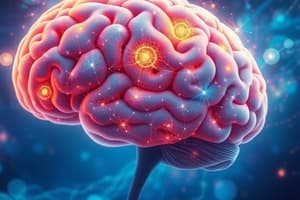Podcast
Questions and Answers
Which function is NOT part of executive functions?
Which function is NOT part of executive functions?
- Deciding on a goal
- Planning how to accomplish the goal
- Understanding spatial relationships (correct)
- Monitoring the execution of the plan
Which area is primarily responsible for the production of speech?
Which area is primarily responsible for the production of speech?
- Wernicke’s area
- Parietotemporal association cortex
- Broca’s area (correct)
- Ventral prefrontal cortex
What does working memory primarily assist in?
What does working memory primarily assist in?
- Deciding on a new goal
- Maintaining goal-relevant information for a short time (correct)
- Long-term storage of information
- Executing plans without monitoring
Which statement about receptive (Wernicke’s) aphasia is true?
Which statement about receptive (Wernicke’s) aphasia is true?
What is apraxia?
What is apraxia?
What is the primary function of the somatosensory cortex?
What is the primary function of the somatosensory cortex?
Which pathway is involved in the primary auditory cortex's processing of sound?
Which pathway is involved in the primary auditory cortex's processing of sound?
Damage to which cortical area is primarily associated with impairments in self-awareness and executive functions?
Damage to which cortical area is primarily associated with impairments in self-awareness and executive functions?
Which association area is primarily involved in the interpretation of sensation and processing of memory?
Which association area is primarily involved in the interpretation of sensation and processing of memory?
Which primary cortex is responsible for processing visual information?
Which primary cortex is responsible for processing visual information?
What type of receptors does the primary somatosensory cortex receive information from?
What type of receptors does the primary somatosensory cortex receive information from?
Which of the following activities is most closely associated with the ventral and medial dorsal prefrontal association areas?
Which of the following activities is most closely associated with the ventral and medial dorsal prefrontal association areas?
How does visual information travel to the primary visual cortex?
How does visual information travel to the primary visual cortex?
Flashcards are hidden until you start studying
Study Notes
Cerebral Cortex
- Processes information from primary sensory cortices for:
- Movement
- Sensation
- Thinking
- Planning
Primary Somatosensory Cortex
- Receives touch and proprioception information via a three-neuron pathway:
- Peripheral afferent/dorsal column neuron
- Medial lemniscus neuron
- Thalamocortical neuron
Primary Somatosensory Cortex Functions
- Discriminative touch and proprioception
- Awareness of sensation through somatosensation
- Determining stimulus location
- Understanding shape, size, and texture
Primary Auditory Cortex
- Receives auditory information from both ears
- Pathway synapses in the inferior colliculus and medial geniculate body before reaching the cortex
Primary Vestibular Cortex
- Receives information about head movement and position relative to gravity
- Information is transmitted via a vestibulothalamocortical pathway
Primary Visual Cortex
- Visual information travels via the retina to the lateral geniculate body of the thalamus, then to the primary visual cortex
Association Areas
- Dorsolateral prefrontal cortex
- Parietotemporal association cortex
- Ventral and medial dorsal prefrontal association cortex
Dorsolateral Prefrontal Cortex Functions
- Self-awareness
- Executive functions:
- Goal setting
- Planning
- Executing plans
- Monitoring plan execution
Parietotemporal Association Cortex Functions
- Cognitive intelligence
- Problem-solving
- Communication comprehension
- Spatial relationship understanding
Ventral and Medial Dorsal Prefrontal Association Cortex Functions
- Impulse control
- Personality
- Reactions to surroundings
Working Memory
- Maintains goal-relevant information for a short time
- Essential for language, problem-solving, mental navigation, and reasoning
- Complex mental multitasking depends on working memory, which is central to cognition
- The prefrontal cortex and parietotemporal association cortex manage, manipulate, and update information in working memory.
Communication
- Wernicke’s area:
- Spoken language comprehension
- Symbol interpretation
- Broca’s area:
- Instructions for language output
- Speech planning movements
- Word correlation when writing
- Instructions for language output
Terms to Know
- Apraxia: Loss of task performance without loss of movement (e.g., agraphia)
- Agnosia: Loss of the sense of touch where significance is lost (e.g., astereognosia, visual agnosia, auditory agnosia, amusia)
- Receptive (Wernicke’s) aphasia: Difficulty understanding spoken language (even with hearing) and other language impairments.
Studying That Suits You
Use AI to generate personalized quizzes and flashcards to suit your learning preferences.




